Structure of Atom | Atomic Structure | Atomic ModelsAtoms are the building blocks of matter. They are the smallest units of elements. For example, a piece of iron is made of a large number of iron (Fe) atoms closely packed together. If we talk about the structure of atom, it can be divided into two parts, nucleus and extra nuclear portion and it consists of three fundamental particles, which are electrons, protons and neutrons. These particles are known as subatomic particles. Properties of subatomic particles
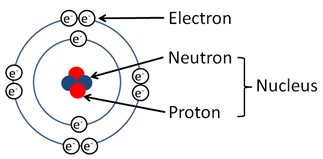
The protons and neutrons are present in the nucleus, which is a very small area present at the centre of the atom. The electrons are present in the extra nuclear portion in different energy shells or levels, which are also known as orbits around the nucleus. The electrons keep revolving in these orbits around the nucleus. The electrons are negatively charged particles, protons are positively charged particles and neutrons are neutral as they have no charge. In a neutral atom, the number of electrons is equal to the number of protons. The structure of the atom was not discovered in a single day, week or year. There were various scientists who performed different experiments to understand the structure of atom over time mainly between 1815 and 1905. In the beginning, according to Dalton's atomic theory, an atom was considered indivisible, which cannot be broken down into smaller particles. Later, in further experiments, the presence of three subatomic particles (proton, neutron and electron) was revealed in atoms and it was found that atom is divisible or it is made of different subatomic particles. Let us see the scientists and their experiments that played an important role in the discovery of electrons, protons and neutrons and thus in revealing or understanding the real structure of the atom. Discovery of sub-atomic particles (particles located inside the atom)i) Discovery of electron:Electron was discovered by J.J Thomson in 1897. He was awarded the noble prize in 1906 for the discovery of the electron. He performed an experiment with a transparent discharge tube. He placed a metal plate at each end of the tube and connected the plates to a high voltage battery. The negative terminal of the battery was connected to one plate, which became a negatively charged electrode called the cathode. Whereas, the positive terminal of the battery was connected to the other plate, which became a positively charged electrode called the anode. 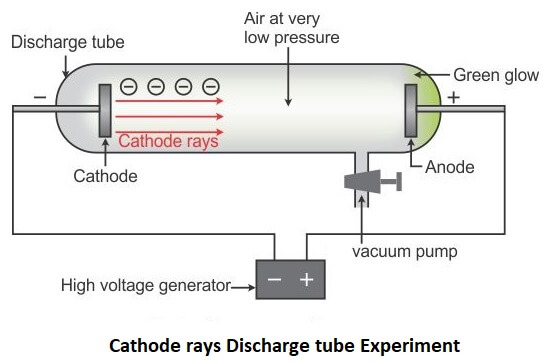
The discharge tube was filled with air or gas at very low pressure and it was fitted with a vacuum pump to reduce the pressure of the gas when required. In the beginning, the pressure of the gas was kept equal to atmospheric pressure and the current was passed through the battery. No changes were observed in the tube. Then the pressure in the tube was reduced to 1mm of Hg through the vacuum pump. This time the tube started glowing so it was clear that at this pressure the current is passing from one electron to the other electrode. The pressure was again reduced to 0.01 mm of Hg. This time tube stopped glowing and became dark from inside, however, he observed a greenish-yellow fluorescent light behind the anode. There was a coating of Zinc sulphide ZnS on the inside of the tube behind the anode that produced fluorescent light. It is the tendency of ZnS to produce such light when it was struck or hit by charged particles. From this, Thomson concluded that when the temperature was at 0.01 mm of Hg and voltage was 10,000 volts, charged particles are produced in the tube that made the ZnS to glow. As cathode was placed to the opposite of anode, so J.J Thomson concluded that charged particles came from the cathode in the form of rays which he called cathode rays. The cathode is a negatively charged electrode so the particles of cathode rays are also negatively charged. Besides this, opposite charge attract each other, so this stream of negatively charged particles travelled toward the positively charged anode and after passing through the anode they strike the ZnS and made it glow. These negatively charged particles of cathode rays were called electrons and thus electrons were discovered by J.J Thomson. The symbol used to represent electron is e-. He said that an atom is a positively charged sphere with electrons randomly distributed or embedded in it. He also said that the atom is electrically neutral. ii) Discovery of Proton:Proton was discovered by Goldstein. After the discovery of electrons in the atom, he thought that there must be some positive charge in the nucleus to neutralize the negative charge of electrons as the atom is neutral. So, he also performed an experiment with a discharge tube containing two electrodes cathode and anode connected to the battery and a vacuum pump connected to the discharge tube. 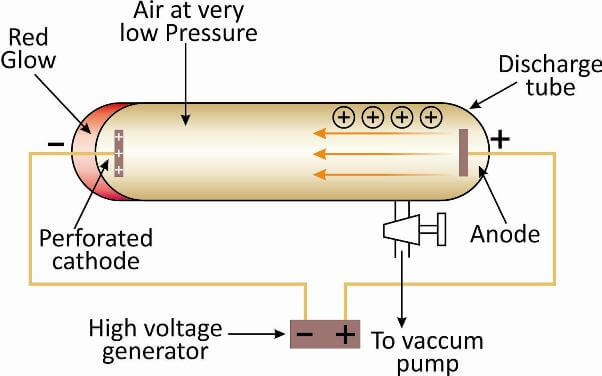
As he was discovering positively charged particles, he placed a zinc sulphide coating behind the cathode. He kept the same pressure and voltage which were used during the discovery of electrons and passed the current. But he did not observe anything. Then he made some perforations (small holes) in the cathode and again performed the experiment. This time the coating started glowing. It showed the presence of charged particles in rays that came from the anode and struck the Zink Sulphide (ZnS) coating after passing through the perforation in the cathode and made the ZnS to glow. These rays of positively charged particles were called anode rays or canal rays. These positively charged particles were called protons, hence, protons were discovered by Goldstein. From the above two experiments, electrons and protons were discovered. Now, after the discovery of electron and protons, the next step was to find the arrangement of these particles in the atom. So, J.J Thomason again in 1904 proposed a model for the arrangement of electrons and protons in an atom, this model was called the plum pudding model. The mass of an electron was very less as capered to a proton. So, he assumed that it is the protons that contributed to the mass of an atom. According to his model, the atom is a sphere of positive charge or positively charged particles (protons) that are uniformly distributed in the atom and the electrons are distributed or embedded in this mass randomly just like seeds of the watermelon are distributed or embedded in its red coloured pulp. So, according to his model, electrons are uniformly distributed but the protons are randomly distributed in it. He also explained his model by relating it to a plum pudding, which is also known as Thomson's plum pudding model. According to this model, the positive charge is uniformly distributed or present in the atom like pudding and electrons are embedded in it like plums. However, the atomic structure suggested by Thomson proved wrong when Rutherford discovered new things about atomic structure by performing an experiment, which is explained below. Rutherford's experimentErnest Rutherford took a thin sheet of gold which was surrounded by the deflection screen which was made of Zinc sulphide (ZnS). It was not completely surrounded as there was a slit on the screen. Then he bombarded a ray of alpha particles through the slit on the thin gold foil. The alpha particles are positively charged particles. 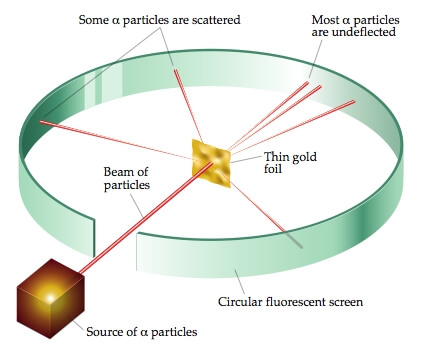
The same charges repel each other and the alpha particles are positively charged as well as heavier than the protons. So, Rutherford expected that the ray of positively charged alpha particles would be deflected as there was a uniformly distributed positive charge in the atom as per the Thomson model. But Rutherford found that most of the rays were passed straight through the gold foil without any deflection and some particles were deflected by small angles and only one ray was appeared to rebound which means followed the same path after deflection. Few rays were deflected by an angle of 180 degrees. The conclusions made by Rutherford based on his experiment are as follows:
Based on the above or his findings, Rutherford proposed an atomic structure, which is known as Rutherford's nuclear model.
Besides this, to explain the stability of the atom, he said that the centrifugal force of revolving electrons neutralizes the force of attraction between the positively charged nucleus and negatively charged electrons. However, this logic was proved wrong. Drawbacks of Rutherford's nuclear model of atom There were some drawbacks in the Rutherford model such as
Thereafter, Neil Bohr, a Danish physicist, proposed a new model of atom to improve the conclusion made by Rutherford. He said that the electrons are definitely revolving but they are revolving in special circular paths, which were called discrete orbits of electrons at that time, which means each electron revolves in a specific orbit. For example, if there are five orbits they will have different orbit radii and energy levels and different electrons revolving in them without interfering with electrons of other orbits. He said that the electrons do not lose energy while revolving in these orbits as these orbits' energy remain fixed. Bohr's model of the atomThe main points given by Bohr through his nuclear model are called postulates of Bohr's model of an atom, which are as follows; 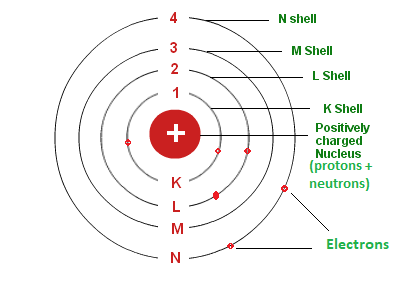
Limitations of Bohr's atomic model
iii) Discovery of NeutronNeutron was discovered by James Chadwick in 1932. It has no charge, however, it has a mass that is equal to the mass of a proton. Neutrons are present inside the nucleus of an atom just like protons. So, an atom's mass is equal to the sum of masses of protons and neutrons. So, after the discovery of neutrons, the atomic structure that we know today was completely discovered.
Next TopicElectronic Configuration
|
 For Videos Join Our Youtube Channel: Join Now
For Videos Join Our Youtube Channel: Join Now
Feedback
- Send your Feedback to [email protected]
Help Others, Please Share









